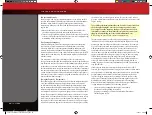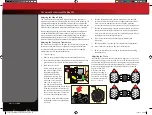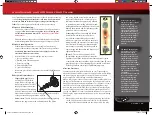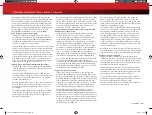
T-MAXX • 27
Before you begin tuning, the engine should be warmed up to its normal
operating temperature and running slightly rich. All final tuning adjustments
must be made to the engine at its normal operating temperature. You can
tell the engine is running rich by noting any of the following:
• Sluggish acceleration with blue smoke coming from the exhaust.
• T-Maxx may not shift into second gear.
• There is unburned fuel spraying from the exhaust tip.
• Leaning the high-speed fuel mixture increases performance.
High-Speed Fuel Mixture Adjustment
With the engine warm and running at a rich setting, gradually lean the
high-speed fuel mixture in 1/16 turn increments. Make several high-
speed passes after each adjustment to clear out the engine and note any
change in performance. The TRX 2.5 is extremely powerful. Remember
to apply the throttle gradually to prevent wheelies or loss of control.
Continue this procedure until there is no longer any performance
improvement.
If any one of the following conditions occurs, the fuel
mixture is already past the maximum safe lean setting:
1.
There is no longer any performance improvement.
2.
The engine begins to cut out at high speed (Danger!).
3.
There is a sudden loss of power during acceleration
(Danger!).
4.
The engine begins to overheat. Symptoms of overheating include:
• Steam or smoke coming from the engine (not exhaust)
• Hesitation or stalling during acceleration
• Popping or clattering sound when decelerating (detonation)
• Fluctuating idle speed
• Temperature measurement above 270°F at the glow plug
(A temperature reading above 270°F alone does not necessarily
indicate overheating. Look for other symptoms of overheating
combined with temperature for a more accurate warning)
Richen the fuel mixture to the optimum setting by richening the
high-speed needle at least 1/8 turn counterclockwise and retest. This
setting will extend engine component life.
Low-Speed Fuel Mixture Adjustment
The low-speed mixture is always set after the high-speed needle is
correctly adjusted. The low-speed mixture is set using the “pinch test”:
1.
Once the engine is warm, do several high-speed runs to confirm
that the high-speed needle is set correctly.
2. Bring the vehicle in and pinch closed the fuel line going into the
carburetor (use the engine shut-off clamp). The engine should run for
2-3 seconds, speed up, and then shut off.
3. If the engine runs longer than 3 seconds, then lean the low-speed
needle 1/16 turn, make several more high-speed runs, and retest.
4. If the engine shuts off immediately without speeding up, then richen
the low-speed needle 1/8 turn, make several more high-speed runs,
and retest.
When the low-speed needle is set correctly, the engine’s throttle response
should be very quick, even to the point of making it difficult to keep
T-Maxx from doing a wheelie when you accelerate!
When adjusting the low-
speed fuel mixture, it is very
important to make several
high-speed runs with T-Maxx
between adjustments to
clear out any excess fuel.
Perform the pinch test
immediately after. If the
engine is allowed to idle
for a long period of time, it
could “load up” with fuel
and give you an inaccurate
measurement from your
pinch test.
Higher nitro requires a
richer fuel mixture. When
running 33% fuel, richen
your high-speed needle 3/4
turn if previously running
20% nitro and then re-tune
the engine for maximum
performance. See page 18
for more information.
Fuel Mixture Adjustment Chart
If the...
is..
then the air
density is...
adjust (correct) the
fuel mixture to be...
Humidity
Lower
Slightly
more dense
Slightly richer
Higher
Slightly
less dense
Slightly leaner
Pressure
(barometer)
Lower
Less dense
Leaner
Higher
More dense
Richer
Temperature
Lower
More dense
Richer
Higher
Less dense
Leaner
Altitude
Lower
More dense
Richer
Higher
Less dense
Leaner
Nitro %
Lower
-
Leaner
Higher
-
Richer
THE TRX 2.5 RACING ENGINE
49104-1-KC2230-R00-T-Maxx-Operating.indd 27
10/30/14 5:10 PM










































